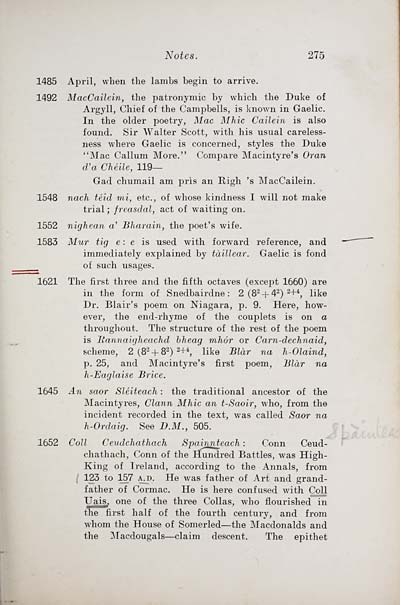Download files
Complete book:
Individual page:
Thumbnail gallery: Grid view | List view

Notes. 275
1485 April, when the lambs begin to arrive.
1492 MacCailein, the patronymic by which the Duke of
Argyll, Chief of the Campbells, is known in Gaelic.
In the older poetry, Mac Mhic Caìlein is also
found. Sir Walter Scott, with his usual careless-
ness where Gaelic is concerned, styles the Duke
"Mac Callum More." ComiJare Macintyre's Oran
d'a Chèile, 119—
Gad chumail am prìs an Righ 's MacCailein.
1548 nach tèid mi, etc, of whose kindness I wiU not make
trial ; freasdal, act of waiting on.
1552 nighean a' Bharain, the poet's wife.
1583 Mur tig e: e is used with forward reference, and
immediately explained by tàillear. Gaelic is fond
_ of such usages.
1621 The first three and the fifth octaves (except 1660) are
in the form of Snedbairdne : 2 (8- + 4^) -+*, like
Dr. Blair's poem on Niagara, p. 9. Here, how-
ever, the end-rhyme of the couplets is on a
throughout. The structure of the rest of the poem
is liannaighcachd hheag mhor or Carn-dechnaid,
fecheme, 2 (8^ + 8^) ^+\ like Blàr na h-Olaind,
p. 25, and Macintyre's first poem, Blàr na
h-Eaglaise Brice.
1645 An saor Slèiteach : the traditional ancestor of the
Macintyres, Clann Mhic an t-Saoir, who, from the
incident recorded in the text, was called Saor na
h-Ordaig. See D.M., 505.
1652 Coìl Ceudchathach Spainnteach : Conn Ceud-
chathach, Conn of the lìundred Battles, was High-
King of Ireland, according to the Annals, from
/ 123 to 157 AAi. He was father of Art and grand-
father of Cormac. He is here confused with Coll
Uais, one of the three Collas, who fiourished in
t"he first half of the fourth century, and from
whom the House of Somerled — the Macdonalds and
the ]\Tacdougals — claim descent. The epithet
1485 April, when the lambs begin to arrive.
1492 MacCailein, the patronymic by which the Duke of
Argyll, Chief of the Campbells, is known in Gaelic.
In the older poetry, Mac Mhic Caìlein is also
found. Sir Walter Scott, with his usual careless-
ness where Gaelic is concerned, styles the Duke
"Mac Callum More." ComiJare Macintyre's Oran
d'a Chèile, 119—
Gad chumail am prìs an Righ 's MacCailein.
1548 nach tèid mi, etc, of whose kindness I wiU not make
trial ; freasdal, act of waiting on.
1552 nighean a' Bharain, the poet's wife.
1583 Mur tig e: e is used with forward reference, and
immediately explained by tàillear. Gaelic is fond
_ of such usages.
1621 The first three and the fifth octaves (except 1660) are
in the form of Snedbairdne : 2 (8- + 4^) -+*, like
Dr. Blair's poem on Niagara, p. 9. Here, how-
ever, the end-rhyme of the couplets is on a
throughout. The structure of the rest of the poem
is liannaighcachd hheag mhor or Carn-dechnaid,
fecheme, 2 (8^ + 8^) ^+\ like Blàr na h-Olaind,
p. 25, and Macintyre's first poem, Blàr na
h-Eaglaise Brice.
1645 An saor Slèiteach : the traditional ancestor of the
Macintyres, Clann Mhic an t-Saoir, who, from the
incident recorded in the text, was called Saor na
h-Ordaig. See D.M., 505.
1652 Coìl Ceudchathach Spainnteach : Conn Ceud-
chathach, Conn of the lìundred Battles, was High-
King of Ireland, according to the Annals, from
/ 123 to 157 AAi. He was father of Art and grand-
father of Cormac. He is here confused with Coll
Uais, one of the three Collas, who fiourished in
t"he first half of the fourth century, and from
whom the House of Somerled — the Macdonalds and
the ]\Tacdougals — claim descent. The epithet
Set display mode to: Large image | Transcription
Images and transcriptions on this page, including medium image downloads, may be used under the Creative Commons Attribution 4.0 International Licence unless otherwise stated. ![]()
| Early Gaelic Book Collections > Matheson Collection > Bardachd Ghaidhlig > (343) |
|---|
| Permanent URL | https://digital.nls.uk/76426334 |
|---|
| Description | Specimens of Gaelic poetry 1550-1900. |
|---|---|
| Shelfmark | Mat.50 |
| Additional NLS resources: | |
| Attribution and copyright: |
|
| Description | Items from a collection of 170 volumes relating to Gaelic matters. Mainly philological works in the Celtic and some non-Celtic languages. Some books extensively annotated by Angus Matheson, the first Professor of Celtic at Glasgow University. |
|---|
| Description | Selected items from five 'Special and Named Printed Collections'. Includes books in Gaelic and other Celtic languages, works about the Gaels, their languages, literature, culture and history. |
|---|

